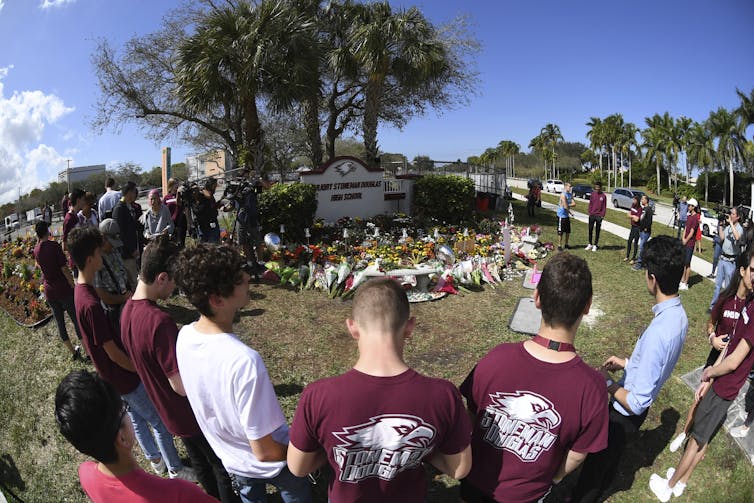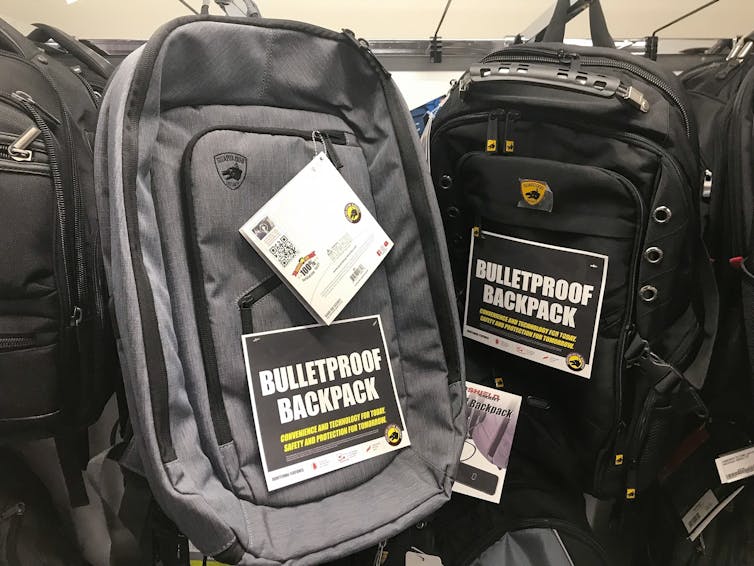Keeping students safe is a growth industry struggling to fulfill its mission
- Written by John S. Carlson, Professor of School Psychology, Licensed Psychologist, Health Service Psychologist, Nationally Certified School Psychologist, Michigan State University
In the 25 years I’ve spent working as a school psychologist and professor of school psychology[1], I’ve never seen so much federal, state and local money spent to “harden[2]” school buildings and campuses.
The term encompasses a wide array of steps being taken to keep students safe amid increasingly frequent mass shootings[3]. Examples include arming teachers[4], conducting active-shooter drills[5] and installing surveillance systems[6].
It’s a booming business that by 2017 had become an estimated US$2.7 billion[7] industry with about $1.5 billion directed toward K-12 school safety.
But based on my research on school safety practices[8], I believe that – in addition to doing more to regulate access to automatic weapons[9] – what’s actually needed is more funding for mental health services in communities and schools[10] to help heed and address warning signs[11] before someone becomes violent.
New architecture
With the federal government’s 2018 commitment to spend $1 billion[12] over the next decade and states like Florida allocating hundreds of millions more[13] in 2019 for school safety initiatives, changes are happening everywhere.
Most money to date has been focused on changes to school buildings.
In Fruitport, Michigan, the local school district spent $48 million to improve school safety[14] through a high school renovation.
The money is paying for curved hallways to reduce a shooter’s line of sight, concrete “wing walls[15]” that jut out a few feet to create a physical space for people to seek cover from gun shots, impact-resistant windows[16] to protect students and staff from glass shattered by gunfire and technology that makes it possible to instantly lock classroom doors[17] when someone perceives a threat.
Likewise, Connecticut gave Newtown a $50 million grant to help it build a new Sandy Hook Elementary School[18] to replace the one that was demolished after the 2012 mass shooting[19] that killed 20 children and six adults at the school.
The new building’s automatically locking classroom doors[20] and other safety features meet the state’s beefed-up guidelines[21], which in turn were heavily influenced by the Department of Homeland Security’s recommended standards[22].
In Oregon, the Bend-La Pine school district is spending millions to build “safety vestibules[23]” – locking entryways that can slow or prevent access through the front door.
 A year after the 2018 Parkland mass shooting, people gathered to mourn.
mpi04/MediaPunch via AP[24]
A year after the 2018 Parkland mass shooting, people gathered to mourn.
mpi04/MediaPunch via AP[24]
More surveillance
Two decades after the Columbine High School shooting[25], video surveillance systems have become the norm. The share of public schools with security cameras[26] shot up from one in five in the 1999-2000 school year to four in five by the 2015-2016 school year.
Gunshot-detection technology is spreading too. In Wisconsin, the Kenosha School District used $384,000 in state funds[27] to install a system that instantly alerts the police following gunshots, turns on video surveillance systems and triggers automatic door locks.
And many states are making arming teachers and other school personnel[28] a priority. Nineteen states let anyone with permission from school authorities to have firearms on school grounds[29].
Florida recently became the sixth state[30], joining Missouri, Oklahoma, South Dakota, Tennessee and Texas, where teachers who meet certain conditions may carry weapons.
Meanwhile nearly two-thirds of U.S. parents[31] say they are at least somewhat worried about the possibility of gun violence at their child’s school. These fearful moms and dads are buying their children bulletproof backpacks[32] and vests[33].
 Sales of bulletproof backpacks rise after mass shootings.
AP Photo/Teresa Crawford[34]
Sales of bulletproof backpacks rise after mass shootings.
AP Photo/Teresa Crawford[34]
The limits
I’m leading a team of researchers[35] that’s studying whether these efforts make a difference. Through our close examination of the literature and affirmed by a soon-to-be published study[36], there is no evidence that architectural and equipment hardening measures prevent or reduce firearm violence in schools.
At the same time, we’re growing more concerned that there is no way to protect all school spaces, including the portable classrooms used extensively across the country[37] to relieve overcrowding, and open spaces like playgrounds and football fields.
That became more evident when six people[38] were shot and others were injured inside a high school stadium in Alabama[39] as the 2019-2020 school year got underway.
In addition, the presence of armed school resource officers[40] does not appear to be associated with a reduction in shooting severity, according to a study released in the summer of 2019.
In part, that study looked at the deaths of 17 people at Marjory Stoneman Douglas[41] High School in Parkland, Florida, in 2018. The officer on hand was subsequently criminally charged[42] because he didn’t confront the shooter.
The school’s surveillance systems fell short too. Video of the incident unfolding was on a 20-minute delay[43].
In some cases, security measures don’t only fail to perform – they backfire. There have been at least 60 incidents of firearm mishandling[44] in schools in the past five years, most of which didn’t result in injuries. And the prospect of monitoring everyone in schools in real-time[45] with artificial intelligence analytics to infer the meaning of movements and behavior is stirring debates[46], with critics raising privacy concerns.
What else can be done
In my view, the need to focus on human behavior and what’s known about the thoughts, feelings and actions of school shooters deserves more attention and funding.
A 2002 Secret Service analysis of 37 school shooting incidents[47] found that 98% of shooters perceived a major loss prior to the attack, 78% had a history of suicide attempts or suicidal thoughts, 73% had a prior grievance against at least one person they were targeting and 71% reported feeling bullied, threatened or were previously injured by others.
The government agency’s subsequent 2019 report on 27 attacks[48], which included many that took place outside of schools, and sociologist Kathryn Farr’s research on 31 school shooters[49], published in 2018, had similar findings to the original Secret Service analysis.
There are two other kinds of hardening approaches, which my team is calling procedural and psychological. Psychological approaches emphasize the behavioral characteristics of people who may wish to harm themselves or others.
Procedural measures include requiring all visitors to sign in and out of school buildings and establishing clear protocols to follow during active shooter situations. Active shooter and lockdown drills[50] are another example, but a recent study shows these could be actually making students feel less safe[51].
In addition, apps like Ok2Say[52] or Fortify FL[53] make it easier to anonymously report suspicious or threatening behavior. Tips from the public may have staved off numerous mass shootings, including in schools[54], in August 2019.
On top of doing more to promote mental wellness[55], promising psychological approaches include assembling school threat assessment teams[56], updating discipline policies[57] and improving both the relationships between teachers and students[58] and school cultures overall[59].
These options generally costs less than renovating buildings or installing new surveillance equipment and may require only shifting some staff responsibilities[60]. We’re finding evidence that they work to get students with homicidal or suicidal tendencies[61] to get the the supports they need and have few downsides.
As school fortification has grown, so too has the number of deaths[62] from shootings on school grounds[63]. There were a total of 22 gunfire incidents on school grounds[64] in the first six and a half months of 2019, CNN reported, in which people were injured or killed.
Even amid the current rush to spend more on armed guards and gun-defensive architecture, I don’t believe changes in school architecture, adding armed guards and bulking up on surveillance technology on their own can prevent future school shootings[65]. I support a more comprehensive approach like the one an interdisciplinary group of school safety experts[66] recently proposed.
[ Insight, in your inbox each day. You can get it with The Conversation’s email newsletter[67]. ]
References
- ^ professor of school psychology (carlsoj.wordpress.com)
- ^ harden (www.the74million.org)
- ^ frequent mass shootings (www.sciencedaily.com)
- ^ arming teachers (educationvotes.nea.org)
- ^ active-shooter drills (nces.ed.gov)
- ^ surveillance systems (www.channel3000.com)
- ^ $2.7 billion (technology.ihs.com)
- ^ research on school safety practices (saidoosy.wixsite.com)
- ^ automatic weapons (www.axios.com)
- ^ mental health services in communities and schools (www.future-ed.org)
- ^ warning signs (wjla.com)
- ^ $1 billion (www2.ed.gov)
- ^ hundreds of millions more (www.fldoe.org)
- ^ spent $48 million to improve school safety (www.freep.com)
- ^ wing walls (www.michiganradio.org)
- ^ impact-resistant windows (www.educationdive.com)
- ^ instantly lock classroom doors (madison.com)
- ^ new Sandy Hook Elementary School (www.curbed.com)
- ^ 2012 mass shooting (theconversation.com)
- ^ automatically locking classroom doors (www.washingtonpost.com)
- ^ state’s beefed-up guidelines (portal.ct.gov)
- ^ recommended standards (www.dhs.gov)
- ^ safety vestibules (www.bendsource.com)
- ^ mpi04/MediaPunch via AP (www.apimages.com)
- ^ Columbine High School shooting (theconversation.com)
- ^ public schools with security cameras (nces.ed.gov)
- ^ Kenosha School District used $384,000 in state funds (dailyreporter.com)
- ^ arming teachers and other school personnel (c0arw235.caspio.com)
- ^ firearms on school grounds (www.ncsl.org)
- ^ sixth state (www.ncsl.org)
- ^ two-thirds of U.S. parents (www.pewresearch.org)
- ^ bulletproof backpacks (www.mcall.com)
- ^ vests (www.elitesterlingsecurity.com)
- ^ AP Photo/Teresa Crawford (www.apimages.com)
- ^ team of researchers (saidoosy.wixsite.com)
- ^ soon-to-be published study (doi.org)
- ^ used extensively across the country (nces.ed.gov)
- ^ six people (www.apnews.com)
- ^ inside a high school stadium in Alabama (www.wkrg.com)
- ^ armed school resource officers (doi.org)
- ^ Marjory Stoneman Douglas (www.cnn.com)
- ^ criminally charged (www.local10.com)
- ^ 20-minute delay (www.nbcmiami.com)
- ^ 60 incidents of firearm mishandling (www.politico.com)
- ^ monitoring everyone in schools in real-time (www.forbes.com)
- ^ stirring debates (thenextweb.com)
- ^ 2002 Secret Service analysis of 37 school shooting incidents (www.secretservice.gov)
- ^ 2019 report on 27 attacks (www.secretservice.gov)
- ^ research on 31 school shooters (doi.org)
- ^ Active shooter and lockdown drills (www.nasponline.org)
- ^ making students feel less safe (psycnet.apa.org)
- ^ Ok2Say (www.michigan.gov)
- ^ Fortify FL (getfortifyfl.com)
- ^ numerous mass shootings, including in schools (www.cnn.com)
- ^ promote mental wellness (www.nasponline.org)
- ^ threat assessment teams (www.dhs.gov)
- ^ discipline policies (www.forbes.com)
- ^ relationships between teachers and students (www.apa.org)
- ^ school cultures overall (www.nasponline.org)
- ^ staff responsibilities (edwp.educ.msu.edu)
- ^ homicidal or suicidal tendencies (doi.org)
- ^ number of deaths (www.cdc.gov)
- ^ shootings on school grounds (theconversation.com)
- ^ 22 gunfire incidents on school grounds (www.cnn.com)
- ^ prevent future school shootings (doi.org)
- ^ an interdisciplinary group of school safety experts (www.nasponline.org)
- ^ You can get it with The Conversation’s email newsletter (theconversation.com)
Authors: John S. Carlson, Professor of School Psychology, Licensed Psychologist, Health Service Psychologist, Nationally Certified School Psychologist, Michigan State University

